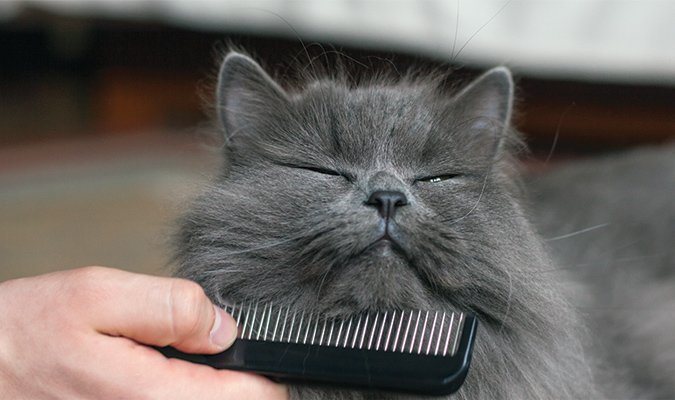jakubzak92 | Deposit Photos

Visable dandruff is rarely normal. It may indicate a problem in our care or an underlying health problem.
“All animals have very active skin, where new cells are produced every day and the old, dead cells are sloughed off into the environment,” says Dr. William Miller, VMD, DACVD, Dermatology Section Chief at the Cornell University College of Veterinary Medicine. “This shedding usually is invisible because the sloughed cells are so small.”
Imbalances in the amount of sebum on the skin can cause the skin to look and behave differently. “If the lipids or fluids within the skin are abnormal then the cells are sloughed in sheets that are visible to the naked eye. If the skin is diseased, it can produce more cells than normal and those aren’t shed normally—hence dandruff,” says Dr. Miller.
Causes
Allergies and parasite infestations are often first noticed as changes in the skin. A cat with allergies may exhibit red, itchy, flaking, and/or irritated skin. A cat with fleas may have flaking or irritated skin along his back and hind end. The fungal infection ringworm typically appears as a bald circular patch of flaking skin. More serious causes of dandruff include diabetes, hyperthyroidism, and other hormonal imbalances.
However, dandruff may be due to controllable causes, such as low humidity, sunburn, bathing with a shampoo not formulated for cats, or even stress. It also may be due to a cat who has difficulty grooming himself. The debris and excess sebum buildup causes dandruff, usually with greasy, unkempt hair.
Worry or Not?
“Dandruff caused by low humidity typically is no big deal,” says Dr. Miller. So, if your skin has been dry and itchy lately, too, a humidifier may make everyone in the house more comfortable. If there has been a stressful change in your cat’s routine, such as a move or adding a new pet, the dandruff should resolve once he has adjusted.
Persistent dandruff or dandruff accompanied by other symptoms is more concerning. “If the dandruff is due to too little fat in the skin or if the cat has a skin disease, then the dandruff indicates a health concern,” says Dr. Miller. A veterinary exam is in order to rule out disease and discuss any changes in your cat’s behavior or environment that might give clues to the cause of the dandruff.
Diagnostic measures include a comb check for fleas and a skin scrape for fungal infections, mites, and signs of skin disorders. Bloodwork will provide clues about systemic diseases and hormonal imbalances that may be causes.
Treatment
“The best thing is to figure out the cause for the dandruff and fix that,” says Dr. Miller. “From a cosmetic point of view, the dandruff can be removed by combing or bathing.” Underlying conditions such as dermatitis, diabetes, flea-bite allergy, or hyperthyroidism will require appropriate treatment to resolve the dandruff along with other symptoms.
Daily brushing stimulates the skin and removes dead hair and debris, and is a great bonding activity. Try different brushes to see what he likes and start by only brushing for a few minutes at a time.
For the cat who is otherwise healthy with clean, pink skin, it’s bath time! Choose a shampoo that is formulated for cats, as your favorite suds may just make his dry skin worse. Limit baths to once every two to three weeks (or less frequently), unless otherwise directed by your veterinarian.



